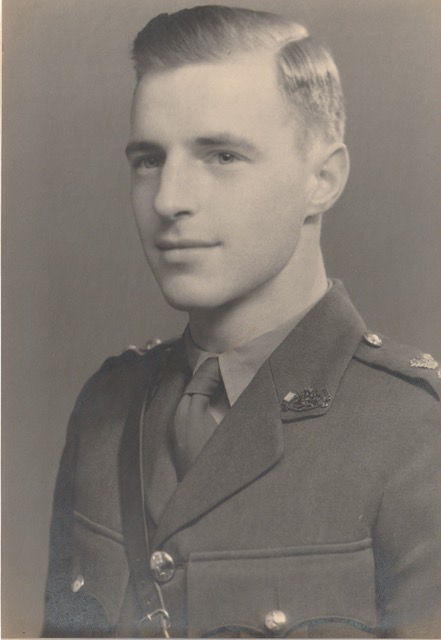
1918 - 2013
George Baker was raised in Kentville, NS, which he called home for the rest of his life. As a youth, he was immersed in the scouting movement, becoming a King’s Scout, and was selected to attend the 1933 World Scout Jamboree in Hungary. He was also a militiaman with the King’s Canadian Hussars. He entered RMC in 1936 with a class that would graduate early in 1939, due to the wartime closure of the college. He excelled in maths and sciences and held supervisory roles in each year. In his Third Year, Baker excelled in the annual College rifle and pistol match, achieving the highest individual score while he also received the Lieutenant Governor’s Medal for the strongest academics. He was commissioned in 1939, joined the Royal Canadian Corps of Signals and deployed to England in 1940.
There, Baker carried out telephone line construction, then in 1942 transferred to wireless operations. He rose quickly through the ranks, was promoted to Major, commanded a signals company and was appointed in 1943 as Senior Advisor Wireless to the Chief Signals Office. He was appointed in 1945 as a Member of the Most Excellent Order of the British Empire for planning and implementing the signals portion of the D-Day deception plan and for subsequent management of communications for the Canadian Army’s advance eastward.
Upon returning to Canada, Baker was discharged in 1945. He then studied Electrical Engineering at the University of Toronto and earned a Bachelor of Arts and Science degree in 1946. He was employed for one year as an engineer with the Canadian General Electric Company, but in 1948 he returned to his hometown and assumed ownership of the family business, the Kentville Publishing Company. During more than thirty years at the helm as Owner and President, he modernized equipment and processes, expanded operations, and tripled the number of employees. He became President of the Canadian Newspaper Association in the late 1950s.
Throughout the 1960s and 1970s, Baker worked in the field of electrical technology as an engineer, consultant, or manager with two companies. He was the Vice-Chairman of the Nova Scotia Medical Care Insurance Commission, with which he established the provincial medical services insurance program.
Living in proximity to the Bay of Fundy, Baker became convinced that the tides of the Minas Basin should be able to supply significant electric power for the economy’s needs. In 1972, he began realizing his dreams when he prompted the Nova Scotia government to launch such an endeavour. He was invited to join what became known as the Tidal Power Review Board Engineering and Management Committee to study of the economic, social, and environmental consequences of power development in the Bay. He eventually became Vice-President of the Nova Scotia Tidal Power Corporation, responsible for the design and construction in 1982 of the Annapolis Royal Tidal Power Station.
For his vision in creating the first tidal power station in North America, Baker was invested in 2000 as a Member of the Order of Canada. His citation states that the facility at Annapolis Royal established Canada as an innovator in the harvesting of alternative energy sources.
After leaving the Corporation in 1989, he remained active in the field and developed an international reputation as a tidal power expert, advising the World Energy Council on the availability of renewable energy sources.
For his achievements in the worlds of business and technology, Baker was made an Honorary Doctor of Engineering by RMC in 1988, an Honorary Doctor of Engineering by the Technical University of Nova Scotia in 1986 and an Honorary Doctor of Civil Law by Acadia University in 1993. In 1994, during a special convocation at RMC, Baker, along with other former cadets whose studies were shortened during wartime, was awarded a Bachelor of Military Science.
Baker was a Professional Engineer, a Fellow of the Engineering Institute of Canada, a Fellow of the Canadian Academy of Engineering, and a recipient of the Institute of Electrical and Electronic Engineers Centennial Gold Medal.
He was an avid hunter, fisherman and sailor all his life. A championship marksman, he began his competitive shooting career in 1936 at the provincial and national championships. In 1946, he won the Nova Scotia Grand Aggregate Award and the Governor General’s Match, which qualified him to represent Canada for the British Empire shooting competitions at Bisley.
Plaque inscription:
Planner, Engineer, Publisher, Visionary